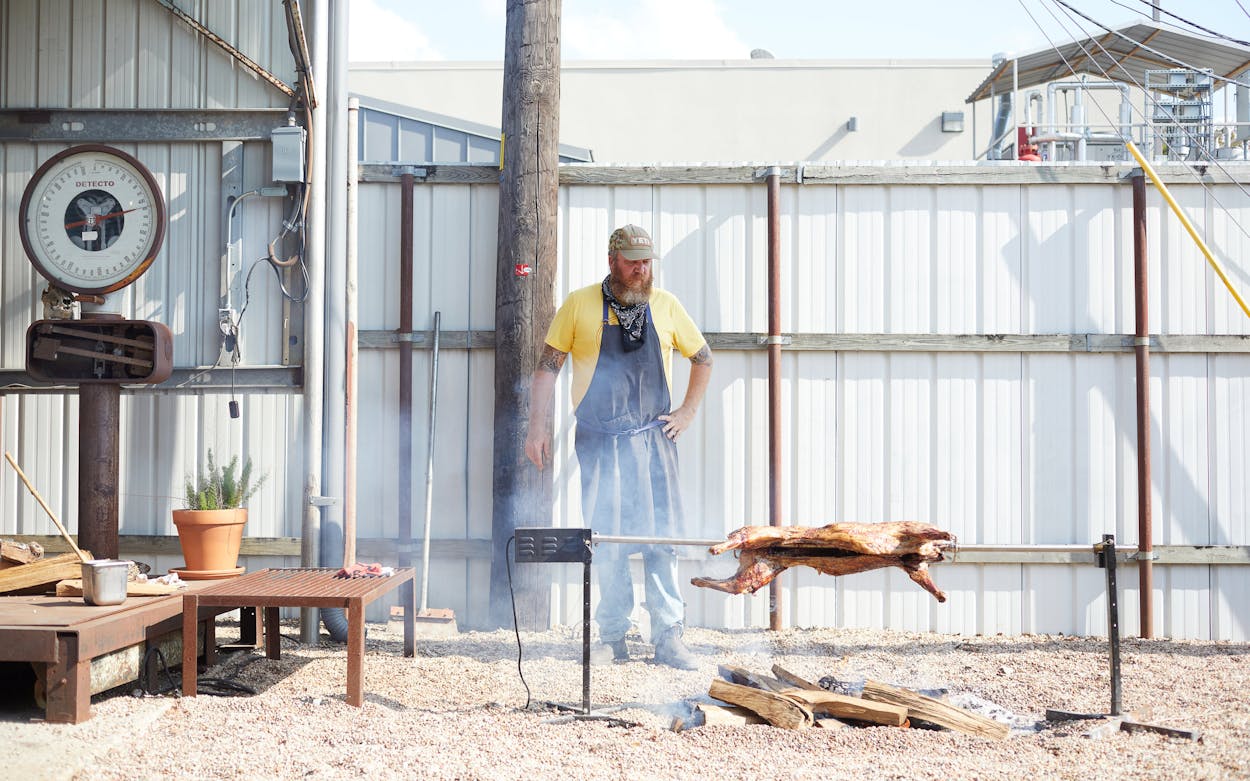Jesse Griffiths is a man with a mission. As anyone who has eaten at his Austin restaurant Dai Due, taken one of his wild-hog hunting classes, signed up for his wild-hog meat subscription box, or offhandedly mentioned this invasive species in his presence can attest, Griffiths is passionate about getting Texans to eat wild hog. “We’re sitting in front of a really unique problem with them. As I’ll discuss at length, given any opportunity,” Griffiths says. “They’re terribly invasive and destructive, but also pretty good to eat. I actually just cooked some this morning.”
According to Texas Parks and Wildlife, there were an estimated 2.6 million hogs in Texas as of 2016, and thanks to a high reproduction rate and virtually no natural predators, the national population swells by 18 to 21 percent annually. Wild hogs are responsible for crop destruction, car accidents, and fecal water pollution, to name a few of the many ways they negatively impact the ecology, agriculture, and economy of Texas. State regulations allow licensed hunters to both shoot and trap hogs, and private landowners don’t need a license to kill hogs that are causing damage to their property. Hogs are more than a nuisance: they are a hazard. But if there is one silver lining, as Griffiths might say, they are also delicious.
Now, in addition to his other efforts, Griffiths has written a book about turning wild hogs into food. The Hog Book: A Chef’s Guide to Hunting, Preparing, and Cooking Wild Pigs is not your typical cookbook: its focus ingredient, while more than abundant across Texas, isn’t something you can just pick up at the supermarket. The book starts at the very beginning, with a shotgun in a field in the middle of the night. Griffiths walks the reader onward through the process—from field dressing to butchery to storage—before he gets to a single recipe.
When properly prepared, wild hog dispels the many myths Griffiths encounters when he discusses eating these invasive animals, including some people’s insistences that they are completely inedible. “People say the most outlandish things,” Griffiths says. “‘You absolutely cannot eat a feral hog. You will get sick and die.’ Well, if that’s the case, I’m a walking miracle.” Others object to a perceived funky flavor, especially on meat from larger male hogs. Griffiths says there are a number of ways to address flavor concerns, first by taking care in the processing of the animal, and later in the cooking of the meat.
After about a hundred pages dedicated to getting the hog from the field to your freezer—a process beautifully photographed in all its gory detail by Jody Horton—Griffiths starts in on the recipes. These are divided into four groups organized by hog size, each of which Griffiths says needs to be treated differently in order to achieve the best possible flavor. The three-hundred-plus pages of recipes include basic slow-roasted meat, internationally inspired stews, sausages, cured treats, and smoked meats (this is, after all, Texas). Griffiths also includes pantry preparations like rendered lard and hog stock.
The Hog Book is an epic work; one with vision and drive and, frankly, a pretty specific target audience. In order to ensure the book could cover the full spectrum of wild-hog cooking—from pulling the trigger alone in a field to serving wild boar burgers to your pals—as thoroughly and viscerally as it does, Griffiths chose to self-publish. He has gone the traditional publishing route before, with his 2012 tome Afield, but for this book he wanted full editorial control, including the ability to publish not only graphic and detailed photographs of the field-dressing and butchery processes, but a ton of them. “You are not going to go through this process without getting your hands dirty,” he says, and the book needed to reflect that reality without being “impeded by any outside editorial influence.” After a successful funding via Kickstarter, the first edition of the book was released this summer. Preorders are currently being taken for another printing.
Griffiths knows that not everyone is a potential hog hunter, but encourages anyone interested in working with this meat to seek it out. “It’s very important to unapologetically regard the non-hunting community as part of this process,” he says, adding that you might just have a hog hunter living down the street who would be willing to share his loot. If not? Broken Arrow Ranch in Ingram sells Texas wild-hog meat to all fifty states, and D’Artagnan also sells nationwide. Either way, Griffiths would love for Texans to try eating wild hog, if only because it would mean less supermarket meat produced by “a fairly broken food system,” he says. “Every pound you’re able to lay your hands on is one less pound that has to be fenced in, gone to a slaughterhouse, vet bills, GMO, soy, and corn.” And it’s one less hog wreaking havoc on the Texas countryside.
- More About:
- Books
- Texas Cookbooks







